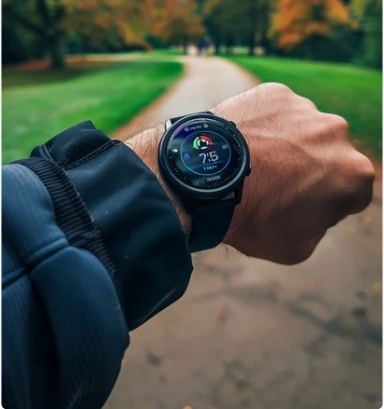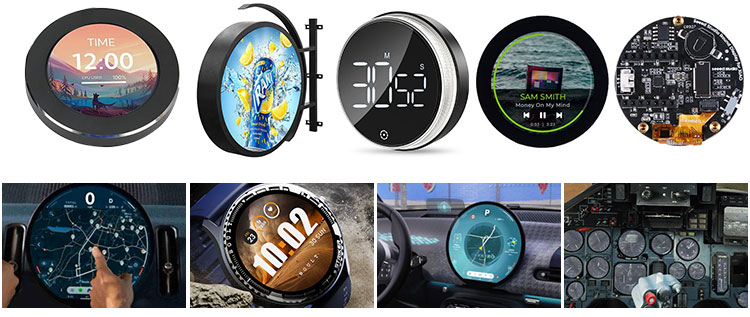Round LCD and OLED circular displays, while similar in some respects, have key differences due to the distinct underlying technologies. Both are used in a variety of applications, especially in consumer electronics, wearables, and automotive displays. Here's a breakdown of the features specific to Round LCD and Round OLED circular displays:

Round OLED Displays
True Black Levels & High Contrast
1. OLED displays offer true black levels since each pixel emits its own light. This results in higher contrast ratios compared to LCDs, making them better for viewing in dark or low-light environments.
2. Ideal for deep, rich colors and high-quality visuals.
Flexibility
OLED technology can be produced on flexible substrates, making it possible to create curved or even foldable screens. This flexibility makes it perfect for creating round displays in compact and ergonomic forms like smartwatches.
Superior Viewing Angles
OLEDs maintain consistent brightness and color accuracy from almost any angle. This is especially important in round displays, where the user may view the screen from various perspectives.
Energy Efficiency with Dark Themes
OLED displays are more energy-efficient when displaying darker content since black pixels are actually turned off, unlike in LCDs where the backlight remains on. This can extend battery life in portable devices (like smartwatches) if using dark UI themes.
Faster Response Time
OLED displays have faster response times than LCDs, making them ideal for dynamic content such as video or gaming, where motion blur and latency need to be minimized.
Thin and Lightweight
OLED panels are generally thinner and lighter than LCDs, which is particularly beneficial in wearable devices like round smartwatches. The absence of a backlight layer contributes to the thinness.
Color Accuracy & Vibrancy
OLED displays offer more vivid and vibrant colors, providing more accurate color reproduction. This makes them excellent for high-quality, visually rich content.
Expensive
OLED technology tends to be more expensive than LCD, which can make OLED displays less cost-effective for budget-conscious projects.
Round LCD Displays
Backlight Required
LCD (Liquid Crystal Display) requires a backlight to illuminate the screen, which means it cannot achieve true black levels like OLED. The backlight is always on, and pixels can only block or pass light to create colors and images, leading to less contrast.
Lower Contrast & Black Levels
LCDs generally have lower contrast ratios because of the constant backlight, and black levels aren’t as deep as OLED’s true blacks. In darker environments, this can make the display less visually appealing.
Energy Consumption
LCDs consume more power when displaying dark content, as the backlight is always active. This can drain the battery faster compared to OLED, especially in devices like smartwatches or other portable tech.
Wider Availability & Lower Cost
LCD technology is more common and cheaper to produce than OLED, which can make it a more cost-effective choice for mass-market products, especially in non-premium devices.
Durability
LCDs can sometimes be more durable, particularly in harsh environments. Since they don’t have organic materials like OLEDs, they are generally more resistant to burn-in, though they can still suffer from other issues like backlight bleeding.
Viewing Angles
While modern LCDs have improved viewing angles compared to older models, they still can’t match the wide viewing angles of OLED. When viewed from the side, colors and contrast may shift more noticeably on LCDs.
Thicker and Heavier
LCD displays are generally thicker and heavier than OLEDs due to the backlight layer. While they can still be slim, they won’t match OLED's thinness, especially in portable or wearable devices.
Color Reproduction
While not as vibrant as OLED, LCDs can still offer good color accuracy and sharpness. However, they may not appear as saturated or vivid, especially when used in high-end display contexts like media or photography.
Longer Lifespan
LCDs tend to have a longer lifespan than OLED displays, especially since they don’t suffer from issues like burn-in or pixel degradation. This can make them more suitable for long-term use, especially in applications where static images might be displayed for extended periods (like digital signage).
Common Applications for Round OLED vs. Round LCD Displays
Round OLED Displays:
· Smartwatches: Devices like the Apple Watch and Samsung Galaxy Watch benefit from OLED’s deep blacks, vibrant colors, and energy efficiency, especially when the screen shows darker watch faces.
· Wearable Health Devices: Devices that track health metrics like heart rate and oxygen saturation use OLED to display vital information in a compact form.
· Premium Devices: Luxury devices and products often use round OLED displays for their superior aesthetic appeal and rich visual output.
· Automotive Displays: High-end dashboards and control panels often utilize OLED for their sleek design and high contrast, especially in round gauges and dials.
Round LCD Displays:
· Budget Smartwatches: Less expensive smartwatches or fitness trackers may use round LCDs to keep costs down while still providing adequate performance for basic tasks.
· Digital Clocks: Traditional-looking round clocks or weather stations that don't require the high-end visual quality of OLED may use LCDs for basic time and date displays.
· Consumer Electronics: Low-cost devices like portable radios, digital thermometers, and more often rely on round LCD displays for simpler, less power-hungry applications.
Custom OLED Solutions for Diverse Applications
Brightness from 0-3000 for perfect display effect achievement. 100% NTSC makes the vividness of the picture better and the color transition in the picture more natural.
Color Temperature is positive white at around 5500K, warm white (yellowish) at 3500K and also cool white (cold) at 6500K.
Driver circuit with sufficient voltage and current values to meet output requirements and reduce the secondary development cycle.
Heat dissipation for high-brightness products to advance design of reasonable heat dissipation structure.
Power consumption, we increase the brightness without increasing the power consumption.
Cables, Backlighting also requires cables, either through an FPC connected to the LCD's FPC and controlled through a port, or a separate cable that controls it through a connector.LED life reached the standard of 30K hours Min. 50K, 70K, 100K hours are all achievable.

Circula Display Touch screen,standard type and customization 
Round LCD OLED Circular Displays Driver board/adapter board, standard type and design customization
DEMO board, H-DMl board, other customized board, etc.

Round LCD OLED Circular Displays Embedded Integrated Solution
UART display solution, H-DMl display solution, Window display solution, Android display solution, Raspberry Pi solution, portable secondary screen solution, etc.